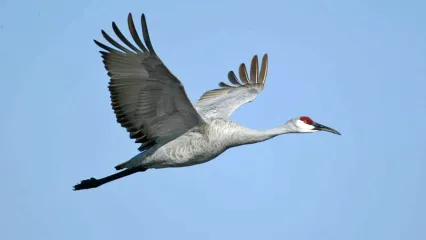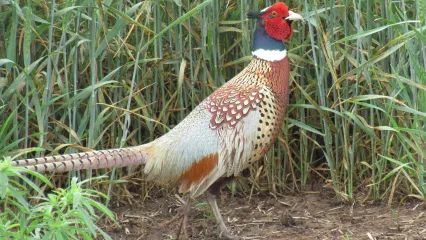
Description
Spend some time in rural western Oklahoma on a breezy early autumn day and you'll likely hear them somewhere in the distance. The shrill trilling or trumpet-like quavering call can carry through the air for more than a mile. It is the distinct call of sandhill cranes passing through the state on their migration south. The sandhill crane (Grus canadensis) is one of the two crane species native to North America.
Cranes are omnivorous ground feeders and will eat frogs, rodents, insects, bulbs, seeds and berries, as well as aquatic invertebrates. They have adapted to agriculture by feeding on waste grain and small animals in farm fields.
Sandhill cranes are well known for their lively dancing displays. Their display is usually associated with a courtship ritual, but it can also be used in aggression, facilitating pair formation and sexual synchronization. The dance includes bowing, skipping and jumping, and cranes will also pick up sticks and repeatedly throw them up in the air. When it occurs in a flock, dancing will start slowly with one bird, and as other birds join in, the tempo speeds up. It is a remarkable sight.
Sandhill crane fossils dating back 6 million years have been found in Nebraska, making it the oldest bird species still living today. They were hunted by native people and early pioneers for their meat, which has earned the nickname "ribeye of the sky." Through regulated management, sandhill cranes can still be hunted in Oklahoma.
Size
It is a large, wading bird with long black legs, long neck and black, chisel-shaped beak. Adults are usually 4 feet tall, with a wingspan of about 6 feet.
Habitat
The lesser sandhill crane subspecies is migratory and can be found during winter in the south-central United States and Mexico. Well over a half-million sandhill cranes make up the mid-continental population, which accounts for at least 80 percent of all sandhill cranes. They migrate along the Central Flyway, making their way north each spring to breed in the north-central U.S., Canada, Alaska and Siberia.
Life Cycle
Sandhill cranes mate for life. Cranes prefer to nest in remote, inaccessible wetland areas. They construct simple nests by scraping vegetation into a mound. In late April or early May, they typically lay two oval eggs. The eggs are greenish or brownish with dark spots.
Males and females take turns incubating the eggs for a month. The chicks are tawny-colored and develop rapidly. Since incubation begins as soon as the first egg is laid, the eggs hatch a day or two apart. The older chick is more likely to survive, and within 10 weeks the young, called colts, are ready to take their first flight. Adult plumage is attained by about two years of age. Mature birds are gray with white cheeks and a bare reddish forehead. Some of the mature birds' plumage takes on a rusty color, which is caused by the iron stain picked up in the peat bogs of their breeding grounds.
How To Observe
Sandhill cranes fly with outstretched necks and have a rapid upstroke when flying. They often fly in long diagonal lines, and sometimes will circle as a flock to take advantage of thermals. Herons are sometimes mistaken for cranes, but they fly with their head and neck tucked back into an "S" shape and only occasionally emit a hoarse croak-like sound.


